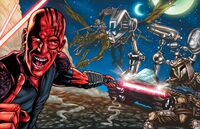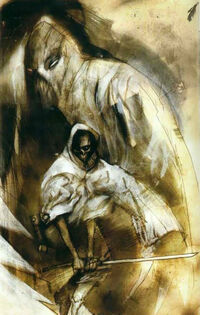- "Young master, have you heard the tale of the Jedi Master Murrtaggh and the Dark Underlord?"
- ―A Bimm bard
In around 1750 BBY during the New Sith Wars, a dark side spirit known as the "Dark Underlord" reigned as a Dark Lord of the Sith. A shadowy figure of unknown origins, he was rumored to have been summoned from the realm of chaos. The Dark Underlord was a male Sith warlord who rose to leadership over the revived Sith Empire, establishing an alliance known as the Black Knights. Based on the planet Malrev IV, the Underlord led a bloody campaign against the Galactic Republic and the Jedi Order, terrorizing the galaxy's Outer Rim Territories. These activities provoked the ire of Murrtaggh, a Jedi Master who—aided by Mandalorian mercenaries—misdirected the Black Knights in a surprise attack against the Underlord's base of operations. This drove the Dark Underlord into a personal confrontation with Murrtaggh himself, during which the Sith Lord met his ultimate demise against the Jedi Master.
Biography[]
Lord of the Sith[]
- "Early in the last war, the Dark Underlord raised an army of Black Knights."
- ―Restelly Quist's writings

A leading Sith general of the Dark Underlord during the Battle of Malrev IV
The entity known only as the "Dark Underlord" was a male individual who existed as a spirit of the dark side of the Force during the New Sith Wars,[2][5] a galactic conflict initiated by the dark side-worshipping Sith Order in 2000 BBY. During this time, the origins of the Dark Underlord remained an enigma, his true nature shrouded behind a cloud of speculation and Sith folklore. One popular theory tied his emergence to the actions of a lone Sith Acolyte, who allegedly summoned the Underlord from the dark, netherworldly realm of Chaos. Another rumor claimed that the Dark Underlord was none other than the reincarnated ghost of Xendor,[2] a powerful darksider who—thousands of years earlier—fought during the First Great Schism of the peacekeeping Jedi Order.[1]
Despite his shadowy presence,[2] the Dark Underlord rose to prominence in around 1750 BBY, becoming a new leader of the resurgent Sith Empire in a crusade against the Galactic Republic and its Jedi protectors.[1] Having seized the coveted mantle of Dark Lord of the Sith, he garnered infamy as a particularly bloodthirsty marauder, swathing through the frontline of battle and proving more than a match for the Jedi. Standing among the most powerful Sith of his time, the Dark Underlord organized his followers into a Sith alliance called the Black Knights, forming a base of operations on the planet Malrev IV.[2] Commanding his Black Knights, the Dark Underlord led an incursion into the galaxy's Outer Rim Territories, terrorizing numerous space stations along the Zona Miki hyperspace route.[1]
Reviled as a scourge of the Jedi and the Republic,[6] the Dark Underlord and his minions soon provoked the intervention of Murrtaggh, a Jedi Master who had been plotting retaliation against the Dark Lord of the Sith. Unbeknownst to the Underlord, Murrtaggh enlisted a group of Mandalorian mercenaries for a planned surprise attack against the Sith headquarters on Malrev IV. Unwittingly ensnared by Master Murrtaggh's diversionary attack, the Dark Underlord dispatched his Black Knights—commanded by the Sith Lord's leading general—to eliminate the invading Mandalorian forces. This decision left the Underlord vulnerable, however, and allowed the Jedi Master to infiltrate Sith territory, resulting in a confrontation between the pair. Despite his power and deadly reputation, the Underlord met his match and fell at the hands of Murrtaggh, promptly ending the Dark Lord's reign.[2]
Legacy[]
- "Though they fell in battle to the Jedi, the Black Knights have risen again and again over the centuries and may not be entirely silent even today."
- ―Restelly Quist's writings
The death of the Dark Underlord had an immediate impact on Jedi Master Murrtaggh, who fell to the dark side upon slaying the Dark Lord of the Sith.[2] Despite the Underlord's demise, the Sith crusades not only remained undeterred, but grew more dominant over the following centuries of the New Sith Wars.[1] Additionally, the Black Knights—although defeated—reformed their numbers on several occasions in the absence of their fallen master. Even following the eventual Sith defeat at the conclusion of the New Sith Wars,[4][1] the Black Knights remained active during a conflict known as the Fluwhaka revolt. Sometime after 990 BBY, the exploits of the Dark Underlord were briefly detailed in The Jedi Path, a guidebook intended for Jedi Initiates.[4]
Personality and traits[]

The Dark Underlord's true nature remained clouded in rumours, speculation and Sith folklore.
An emotionless dark side spirit,[1][5] the Dark Underlord was an enigmatic figure during the New Sith Wars, leading to much speculation regarding his true nature and origins. Nonetheless, his reign as the Dark Lord was characterized by a penchant for carnage and plunder.[2][1] To this end, the Underlord adopted a hands-on approach as a Sith warlord,[2][6] engaging directly in the thick of battle against the Jedi Order.[2]
Powers and abilities[]
The Dark Underlord was a notably powerful figure among the resurgent Sith of the Draggulch Period, a trait which not only helped him establish dominance over his Sith peers, This made him a singular threat to the Jedi.[2] As a melee combatant, the Underlord was a master of the dual-wielding Jar'Kai combat form, brandishing a pair of Sith swords in preference to the modern lightsabers of his time.[6]
Behind the scenes[]
The Dark Underlord was first mentioned in Heroes & Rogues, a roleplaying supplement released in 1995 for the first edition of Star Wars: The Roleplaying Game.[3] In 2001, another supplement called The Dark Side Sourcebook featured an illustration—drawn by Ashley Wood—depicting a figure described as a "Dark Side Spirit".[5] This image was eventually retconned as a depiction of the Dark Underlord in "Evil Never Dies: The Sith Dynasties," an article written by Abel G. Peña in 2006. The article expanded upon the Underlord's backstory within the New Sith Wars,[2] particularly his ghostly presence as a dark side spirit, a role that Peña originally intended for a separate character known as Blackhole.[7]
Sources[]
- Heroes & Rogues (First mentioned)
- The Dark Side Sourcebook (Picture retcon)
 "The History of the Mandalorians" — Star Wars Insider 80
"The History of the Mandalorians" — Star Wars Insider 80 "The Dark Forces Saga, Part 4" (original article link) on Wizards.com (content now obsolete; backup link)
"The Dark Forces Saga, Part 4" (original article link) on Wizards.com (content now obsolete; backup link)- Vader: The Ultimate Guide
 "Heritage of the Sith" — Star Wars Insider 88
"Heritage of the Sith" — Star Wars Insider 88 Evil Never Dies: The Sith Dynasties on Hyperspace (article) (content removed from StarWars.com; backup link)
Evil Never Dies: The Sith Dynasties on Hyperspace (article) (content removed from StarWars.com; backup link)- Star Wars Annual 2009
- The Complete Star Wars Encyclopedia
- The Essential Atlas
- The Jedi Path: A Manual for Students of the Force
External links[]
 "The Emperor's Pawns Endnotes, Part 3: Blackhole and Revelations" — Only Sith Deal In Absolutes! — Abel G. Peña's StarWars.com Blog (backup link)
"The Emperor's Pawns Endnotes, Part 3: Blackhole and Revelations" — Only Sith Deal In Absolutes! — Abel G. Peña's StarWars.com Blog (backup link)
Notes and references[]
- ↑ 1.00 1.01 1.02 1.03 1.04 1.05 1.06 1.07 1.08 1.09 1.10 1.11 1.12 1.13 The Essential Atlas
- ↑ 2.00 2.01 2.02 2.03 2.04 2.05 2.06 2.07 2.08 2.09 2.10 2.11 2.12
 Evil Never Dies: The Sith Dynasties on Hyperspace (article) (content removed from StarWars.com; backup link)
Evil Never Dies: The Sith Dynasties on Hyperspace (article) (content removed from StarWars.com; backup link)
- ↑ 3.0 3.1 Heroes & Rogues
- ↑ 4.0 4.1 4.2 4.3 The Jedi Path: A Manual for Students of the Force
- ↑ 5.0 5.1 5.2 The Dark Side Sourcebook
- ↑ 6.0 6.1 6.2 The Complete Star Wars Encyclopedia, Vol. I, p. 169 ("Dark Underlord")
- ↑
 "The Emperor's Pawns Endnotes, Part 3: Blackhole and Revelations" — Only Sith Deal In Absolutes! — Abel G. Peña's StarWars.com Blog (backup link)
"The Emperor's Pawns Endnotes, Part 3: Blackhole and Revelations" — Only Sith Deal In Absolutes! — Abel G. Peña's StarWars.com Blog (backup link)
- ↑ According to Echoes of the Jedi, Darth Rivan became a Dark Lord of the Sith sometime between 1,150 and 1,400 years before the events of the story. It can be deduced that Echoes of the Jedi takes place in 17 BBY; the story occurs two years after Order 66, which was declared in 19 BBY per The New Essential Chronology. As such, the earliest time of Rivan's reign can be dated at 1417 BBY. Furthermore, The Essential Atlas confirms 1250 BBY as the beginning date for the rule of Belia Darzu (established as Rivan's successor in Evil Never Dies: The Sith Dynasties), thus providing the latest potential date for Rivan's reign.
